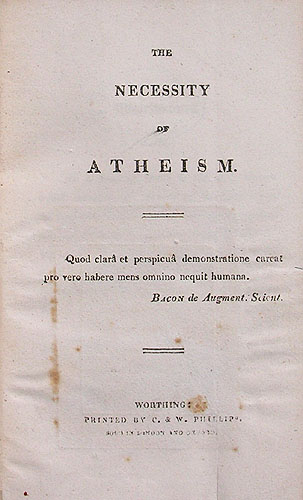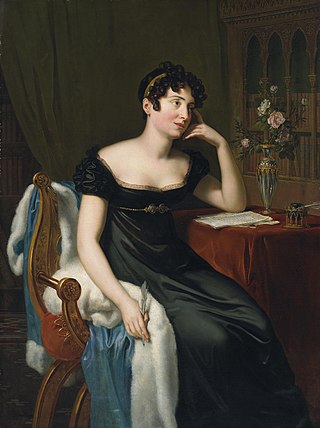This article contains information about the literary events and publications of 1822.
This article contains information about the literary events and publications of 1818.
This article contains information about the literary events and publications of 1811.

"The Necessity of Atheism" is an essay on atheism by the English poet Percy Bysshe Shelley, printed in 1811 by Charles and William Phillips in Worthing while Shelley was a student at University College, Oxford.

Sydney, Lady Morgan, was an Irish novelist, best known for The Wild Irish Girl (1806), a romantic, and some critics suggest, "proto-feminist", novel with political and patriotic overtones. Her work, including continental travelogues, sparked controversy and faced censorship. She counted Percy Bysshe Shelley and Lord Byron among her defenders.
Nationality words link to articles with information on the nation's poetry or literature.
Events from the year 1811 in Ireland.

This is a bibliography of works by Mary Shelley, the British novelist, short story writer, dramatist, essayist, biographer, and travel writer, best known for her Gothic novel Frankenstein: or, The Modern Prometheus (1818). She also edited and promoted the works of her husband, the Romantic poet and philosopher Percy Bysshe Shelley. Until the 1970s, Mary Shelley was known mainly for her efforts to publish Percy Shelley's works and for Frankenstein. Recent scholarship has yielded a more comprehensive view of Mary Shelley’s achievements, however. Scholars have shown increasing interest in her literary output, particularly in her novels, which include the historical novels Valperga (1823) and Perkin Warbeck (1830), the apocalyptic novel The Last Man (1826), and her final two novels, Lodore (1835) and Falkner (1837). Studies of her lesser-known works such as the travel book Rambles in Germany and Italy (1844) and the biographical articles for Dionysius Lardner's Cabinet Cyclopaedia (1829–46) support the growing view that Mary Shelley remained a political radical throughout her life. Mary Shelley's works often argue that cooperation and sympathy, particularly as practised by women in the family, were the ways to reform civil society. This view was a direct challenge to the individualistic Romantic ethos promoted by Percy Shelley and Enlightenment political theories.

Frankenstein; or, The Modern Prometheus is an 1818 novel written by English author Mary Shelley. Frankenstein tells the story of Victor Frankenstein, a young scientist who creates a sapient creature in an unorthodox scientific experiment. Shelley started writing the story when she was 18, and the first edition was published anonymously in London on 1 January 1818, when she was 20. Her name first appeared in the second edition, which was published in Paris in 1821.

History of a Six Weeks' Tour through a part of France, Switzerland, Germany, and Holland; with Letters Descriptive of a Sail Round the Lake of Geneva and of the Glaciers of Chamouni is a travel narrative by the English Romantic authors Mary Shelley and Percy Bysshe Shelley. Published anonymously in 1817, it describes two trips taken by Mary, Percy, and Mary's stepsister, Claire Clairmont: one across Europe in 1814, and one to Lake Geneva in 1816. Divided into three sections, the text consists of a journal, four letters, and Percy Shelley's poem "Mont Blanc". Apart from the poem, preface, and two letters, the text was primarily written and organised by Mary Shelley. In 1840 she revised the journal and the letters, republishing them in a collection of Percy Shelley's writings.

Percy Bysshe Shelley was a British writer who is considered one of the major English Romantic poets. A radical in his poetry as well as in his political and social views, Shelley did not achieve fame during his lifetime, but recognition of his achievements in poetry grew steadily following his death, and he became an important influence on subsequent generations of poets, including Robert Browning, Algernon Charles Swinburne, Thomas Hardy, and W. B. Yeats. American literary critic Harold Bloom describes him as "a superb craftsman, a lyric poet without rival, and surely one of the most advanced sceptical intellects ever to write a poem."

St. Irvyne; or, The Rosicrucian: A Romance is a Gothic horror novel written by Percy Bysshe Shelley in 1810 and published by John Joseph Stockdale in December of that year, dated 1811, in London anonymously as "by a Gentleman of the University of Oxford" while the author was an undergraduate. The main character is Wolfstein, a solitary wanderer, who encounters Ginotti, an alchemist of the Rosicrucian or Rose Cross Order who seeks to impart the secret of immortality. The book was reprinted in 1822 by Stockdale and in 1840 in The Romancist and the Novelist's Library: The Best Works of the Best Authors, Vol. III, edited by William Hazlitt. The novella was a follow-up to Shelley's first prose work, Zastrozzi, published earlier in 1810. St. Irvyne was republished in 1986 by Oxford University Press as part of the World's Classics series along with Zastrozzi and in 2002 by Broadview Press.

Thomas Medwin was an early 19th-century English writer, poet and translator. He is known chiefly for his biography of his cousin, Percy Bysshe Shelley, and for published recollections of his friend, Lord Byron.
George Cannon (1789–1854) was an English solicitor, radical activist and publisher and pornographer who also used the pseudonyms Erasmus Perkins and Philosemus.

Mary Wollstonecraft Shelley was an English novelist who is best known for writing the Gothic novel Frankenstein; or, The Modern Prometheus (1818), which is considered an early example of science fiction. She also edited and promoted the works of her husband, the Romantic poet and philosopher Percy Bysshe Shelley. Her father was the political philosopher William Godwin and her mother was the philosopher and women's rights advocate Mary Wollstonecraft.

Original Poetry by Victor and Cazire was a poetry collection written by Percy Bysshe Shelley and his sister Elizabeth which was printed by Charles and William Phillips in Worthing and published by John Joseph Stockdale in September 1810. The work was Shelley's first published volume of poetry. Shelley wrote the poems in collaboration with his sister Elizabeth. The poems were written before Shelley entered the University of Oxford.

The Triumph of Life was the last major work by Percy Bysshe Shelley before his death in 1822. The work was left unfinished. Shelley wrote the poem at Casa Magni in Lerici, Italy in the early summer of 1822. He modelled the poem, written in terza rima, on Petrarch's Trionfi and Dante's Divine Comedy.

A Vindication of Natural Diet is an 1813 book by Percy Bysshe Shelley on vegetarianism and animal rights. It was first written as part of the notes to Queen Mab, which was privately printed in 1813. Later in the same year the essay was separately published as a pamphlet.

The Man Who Wrote Frankenstein is a 2007 book written and published by John Lauritsen, which defends the unorthodox hypothesis that the poet Percy Bysshe Shelley, not his wife Mary Shelley, is the real author of Frankenstein; or, The Modern Prometheus (1818). The book also argues that the novel "has consistently been underrated and misinterpreted", and that its dominant theme is "male love."

Since the initial publication of Mary Wollstonecraft Shelley's novel Frankenstein; or, The Modern Prometheus in 1818, there has existed uncertainty about the extent to which Mary Shelley's husband, Percy Bysshe Shelley, contributed to the text. While the novel was conceived and mainly written by Mary, Percy is known to have provided input in editing and publishing the manuscript. Some critics have alleged that Percy had a greater role—even the majority role—in the creation of the novel, though mainstream scholars have generally dismissed these claims as exaggerated or unsubstantiated. Based on a transcription of the original manuscript, it is currently believed that Percy contributed between 4,000 and 5,000 words to the 72,000 word novel.












